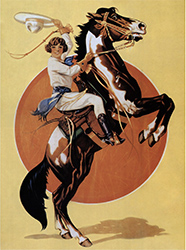By Clare Tone
Clare is a Boulder County Horse Association (BCHA) committee member and freelance writer living in western Boulder County. In this monthly column leading up to our 50th Anniversary she explores the rich history of BCHA.
What does the 1980s conjure up for you—big hair, neon clothing, high-waisted jeans?

For me, because I was in school throughout the 1980s, it represents the transition from analog to digital. The 1980s were a decade of acceleration, but nowhere near the pace of how things zip along today with smartphones and ubiquitous internet connections. In some odd, quirky, time-warp way the culture of the 1980s seems the mirror opposite of our culture today during this pandemic time. While the 1980s marked a kind of technical acceleration, here we are right now forced to slow down. Perhaps a slowing down that could bring us into contact with some of the better qualities of the 1980s.
As a high school student in the early 1980s my assignments were typed on an old relic of a typewriter. By senior year things were clipping along a little better on an electric typewriter with an automatic erasure key! By college I was bogged down trying to learn MS DOS on the very first publicly available personal computers.

Yes, computers were invented by then, but they were so much less efficient than the modes of communication I knew. Supposedly there was some form of e-mail, but most of us kids of the 80s still plugged along slowly to communicate. I wrote longhand letters checking in with family and friends, and waited two weeks for a response. Every Sunday I sat on the floor under the dorm payphone kiosk to call my parents, the cord stretched to my ear, as I glanced up occasionally at the wads of gum stuck to the metal underside.
Sifting Through the Archives
Going through the BCHA archives I see a similar kind of acceleration. A methodical attention to detail ramping up toward great accomplishments. On my desk sits 10 years’ worth of BCHA newsletters, and up to about the mid-1980s they are created on typewriters. Then an almost imperceptible change—post-1985 newsletter editions are clean, dense and tightly laid out using a word-processor. The BCHA Horse Services Directories reflect the same transition from typewriter to word-processor. Many with beautiful cover designs by Lynn Nelson (right).
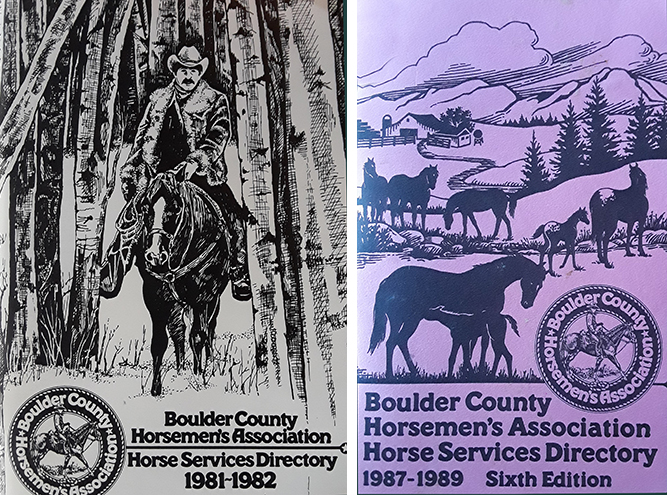
Attention to detail, ramping up to great accomplishments, is also apparent in the dozens of letters meticulously typed out by Pat Militzer in her role as ‘BCHA External Vice President’ during the early 1980s. I imagine her sitting quietly at her desk, with views of horses in a pasture from her window, as she plunked methodically along on her typewriter to articulate clear and passionate messages about what the horsemen of Boulder County were working on.
That clear and passionate work continued through the 1980s accelerating into more and bigger projects.
Growing Pressure
In Boulder County the decade was marked by growing pressure on land-use, zoning and development. According to some who were there and the archives of the era, the 1980s saw BCHA involved in legislation relating to zoning regulations for horse owners, and establishing public riding arenas. There was also significant engagement around city, county and state trails. This included committee representation for acquiring open space land for public riding. In 1983 that the city of Boulder launched a Trails Committee requesting representation by BCHA.
“The purpose of this committee is to develop a comprehensive usage and linkage plan for trails within the Boulder Mountain Parks and Open Space system. … It is hoped that by soliciting input in this manner, a successful long-range trails plan can be adopted. All committee recommendations will be presented to the Open Space Board of Trustees for final approval.”
BCHAs Pat Militzer sat on this committee alongside representatives from the Sierra Club, Colorado Mountain Club, Roadrunners, Mountain Bicycle Coalition, Committee for the Disabled, and the Audubon Society. The scope was not limited to city-wide trail decisions but included comprehensive county and state-level trails.
Just prior to formation of the Trails Committee, BCHA sponsored a survey carried out by the CU Department of Economics exploring the impacts of the horse population of Boulder County. To ‘better understand and represent the needs of horse owners in the county’. Published in 1982, it estimated a total of 16,635 horses in Boulder County, 39% of which were Quarter horses, 23% Arabians, and 12 mules. The survey found almost three-fourths of all horse owners kept their horses on their own property. For those who did board, the average cost was about $123 per month. In 1982 the average annual expenditure per horse (feed, vet care, farrier, training, supplies, equipment, boarding costs etc.) was $1,820. That’s equivalent to $4,902 today. This same economic study found the total monetary injection into the Boulder County economy from horse-related activities was over $30 million dollars (equivalent to almost $90 million dollars today).
We have the engaged BCHA members and leaders of the 1980s to thank. These included Jill Talbot, Judd Adams, Cathy Bickell, Shirley Hyden, Randy Winter, Pat Militzer and so many more that served to provide:
- Representation on the ‘Trails Committee’ (established by City of Boulder in 1983)
- Trail mapping work
- Trail construction (Eldorado Springs Trail to Walker Ranch; Doudy Draw)
- Publication of Trail logs
- Open Space cleanups and trail maintenance projects
- Multiple letters and in-person representation at city, county and state levels
An Engaged Membership
In the spring of 1986, 23 BCHA members donated a handful of days of work building the Doudy Draw trail with the help of Junior Rangers and others. One of those involved was Randy Winter (BCHAs Trail Advisor). In a recent conversation with me, he emphasized the important roles advocacy and education played early-on when it came to preserving equestrian access to open space. As Randy and his contemporaries watched Boulder transition from rural to cosmopolitan, they also saw that folks making decisions about trail use were not necessarily educated when it came to horses. Randy points to the successes that grew out of having a BCHA advisory presence at Open Space meetings throughout the 1980s. In his view, the key was collaboration, education, and an advisory role while minimizing antagonistic interactions, so easy to arise when different trail users attempt to negotiate use of the same trails. While there have been challenges and losses of key equestrian spaces over time, Randy prefers to keep his cup half full. He feels there are always lots of places to ride in Boulder County and that having a positive relationship with other trail users is paramount.
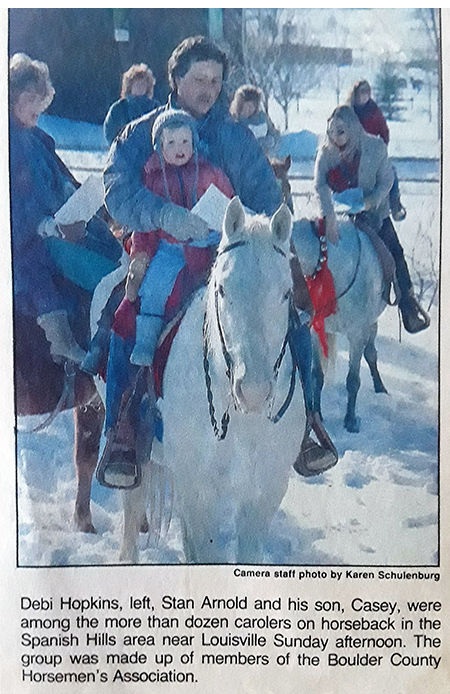 It’s clear throughout the 1980s BCHA was busy with a very engaged membership. In 1986 alone:
It’s clear throughout the 1980s BCHA was busy with a very engaged membership. In 1986 alone:
- BCHA hosted two membership meetings with guest speakers and films, and multiple training seminars. There was an annual dinner meeting, a tack sale/swap, summer gymkhanas, trail rides, and a stallion parade.
- There was a ride for research, and a benefit ride to raise funds for the CSU Equestrian Center.
- There was a fall potluck, monthly newsletters, trail building projects and clean ups, clinics including a competitive trail riding clinic.
- The year finished up with a Christmas party replete with caroling on horseback on the downtown Pearl Street Mall, newly completed in 1977.
Are you exhausted yet, or just wish you were a horse person in Boulder County in the 1980s?
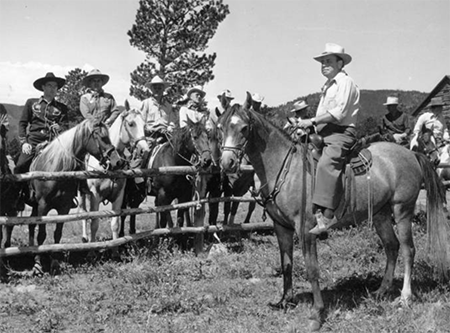
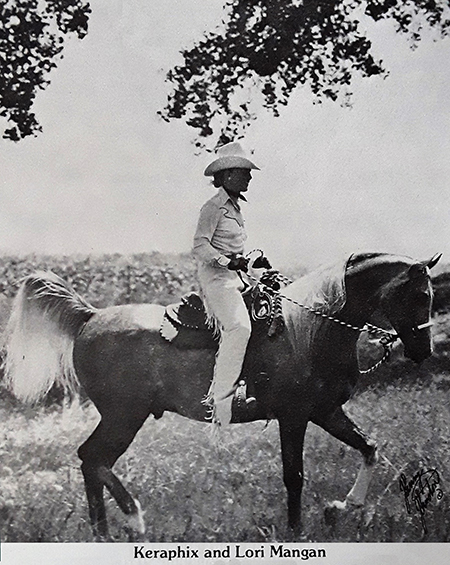 Arabians were a popular breed in the 1980s. In the third edition of the BCHA Horse Services Directory published in 1981 there were no less than 59 Arabian breeders listed in the area. Two of those historic Arabian ranches are now among prized City of Boulder Open Space and Mountain Parks, the Van Vleet Arabian Horse Ranch and the Joder Arabian Ranch.
Arabians were a popular breed in the 1980s. In the third edition of the BCHA Horse Services Directory published in 1981 there were no less than 59 Arabian breeders listed in the area. Two of those historic Arabian ranches are now among prized City of Boulder Open Space and Mountain Parks, the Van Vleet Arabian Horse Ranch and the Joder Arabian Ranch.
- The Van Vleet Arabian Horse Ranch near South Boulder Road and Cherryvale hosted the monthly BCHA board meetings in the early years but by 1978 the land was purchased by the city of Boulder.
- North of town was the well-respected Joder Arabian Ranch. When Anna Joder died in 1983 her family continued running the ranch and founded the Anna Best Joder Memorial Fund to which many BCHA members donated. The goal was to further develop equestrian trails and riding areas in Boulder County. Today, the city of Boulder holds 335 acres of the Joder Ranch through which there are several miles of multi-use trails.
Every era has its trend, a gist it gets across only after it’s over. As the transition from analog to digital took hold throughout the culture in the 1980s we can see a certain intensifying of the passionate and enthusiastic work of BCHA. As letters, newsletters, service directories, meetings and more became focused and concentrated by the aid of digital devices, it’s easy for me to imagine the passionate dedication of our 1980s BCHA leaders and members reaching farther, igniting more horse lovers in the county and beyond. Preserving a little more open space. Helping an Open Space Board of Trustee become a little more horse-enlightened. Creating a little more fun and upliftment for kids at a summer gymkhana.
Perhaps our current times can provide an opportunity to decelerate a bit. To ramp down to achieve great accomplishments. A chance for BCHA members in 2020 to downshift, to calm the incessant pull of high-speed devices toward multi-tasking and instead re-focus. To reach out with enthusiasm and renewed purpose. As our 1980s counterparts implored:
“….Although we work hard, we play hard! Our gymkhanas, horse shows, trail rides and overnights allow us to learn from and enjoy each other as well as our equine friends….You need BCHA and BCHA needs YOU, the horse owner and enthusiast who cares about your EQUINE friends and their future in Boulder County. Join us in our dedication to preserve our equestrian heritage…”
[divider style=”solid” color=”#cccccc” opacity=”1″ icon_color=”#666666″ icon_size=”15″ placement=”equal”]
